Executive Summary
Coming off the first rate cut in a decade, the Federal Reserve Open Markets Committee (FOMC) heads into its September meeting with financial markets not so much considering whether it will cut rates again, but rather by how much and what it will provide in the way of forward guidance. At a speech in Zurich, Switzerland on September 6, Fed Chairman Jerome Powell did little to disabuse financial markets of the widespread expectation of another rate cut in September. Chair Powell enjoys having the last word, as we have now entered the blackout period, the time in the lead-up to the FOMC meeting during which Fed officials refrain from commenting on monetary policy.
In our view, the most likely outcome for next week’s meeting is that the FOMC will cut the fed funds rate another 25 bps, while continuing to emphasize risks to the outlook from global growth and trade policy and acknowledging that inflation remains below target. All told, the meeting should keep the door open for additional easing over the next few months. As we did in our Flashlight publication in July, we handicap various potential outcomes for the September 18 FOMC meeting in this report.
The Days Are Getting Shorter and Darker Since July
With less room to cut rates in this cycle than it has had in the past—the Fed would have 225 bps of “ammunition” if it took rates all the way back to 0%—the Fed must be judicious even to the point of sparring about each rate cut in this cycle (Figure 1). Overall, the labor market remains tight, as evidenced by the unemployment rate remaining near multi-decade lows. Inflation has picked up recently, with the core PCE deflator up at a 2.2% annualized clip over the past three months (Figure 2). However, strictly speaking, at 1.6% year-over-year, the core PCE deflator remains below the Fed’s 2% target, so the FOMC has cover to ease on that basis alone.
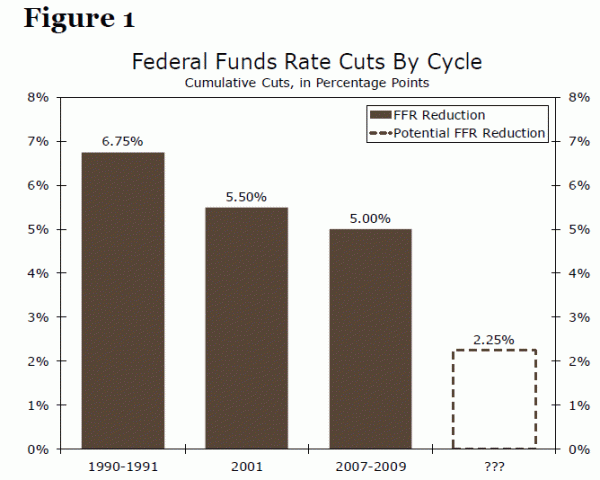
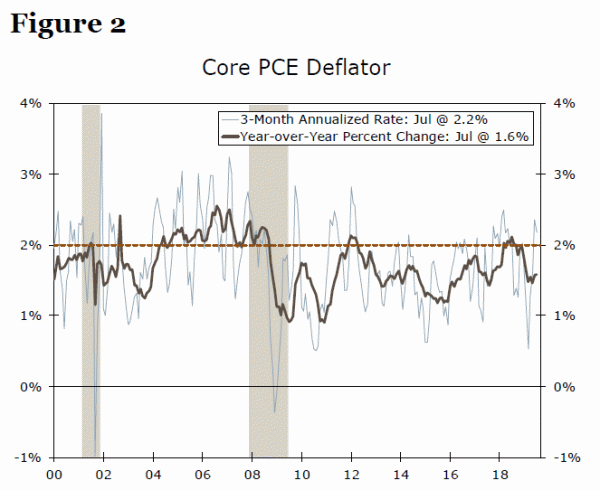
But there are a number of factors affecting the economic outlook that could threaten the Fed’s dual mandate (full employment and stable prices) in the future. For starters, the marked slowdown in U.S. export growth in recent quarters, due to Chinese tariff retaliation and generalized deceleration in global economic activity, could remain a headwind to U.S. economic growth. Trade policy uncertainty is also putting business plans on hold and leading to outright declines in manufacturing. This is most prominent in the ISM manufacturing index, which slipped into contraction territory in August for the first time since 2016.
U.S. households remain in good shape with low debt service, a high saving rate and spending on track for another solid outturn in Q3. But there are signs the trade war is beginning to weigh on consumer sentiment as well. One in three consumers surveyed by the University of Michigan spontaneously mentioned the trade war and tariffs in August as that measure of consumer sentiment fell to its lowest since just before the 2016 election.
With low inflation as a workable justification and with trade-related risks having intensified over the past month and a half, another rate cut in September looks like all but a done deal at this point. Markets are currently pricing in a 100% probability that the FOMC will reduce the fed funds rate next week. For all these reasons, it is arguably less important what the Fed does in September and more important what it will offer in terms of forward guidance, which is our focus in the various scenarios we consider in this report.
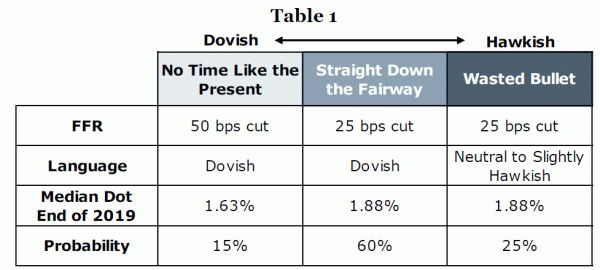
Scenario 1: Straight Down the Fairway
- Fed funds rate: 25 bps cut
- Language: Dovish–Downside risks from trade have increased; maintains pledge to sustain the expansion
- Dots: A sizeable number of dots shift down to 1.63% at end of 2019
- Probability: 60%
The most likely outcome of the FOMC’s upcoming meeting in our view will be another 25 bps cut, with a sizeable number of committee members keeping the door open to further easing. Little has changed in the economic environment, which makes this reprise of the July meeting our base case. Growth still looks to be moderating slightly, with consumer spending solid but investment weakening. Inflation also remains disappointingly low; the core PCE deflator is up 1.6% year-over-year and inflation expectations hover near historic lows.
More significantly, the risks to the U.S. economy from slowing global growth and trade policy have intensified since the last Fed meeting. Although trade talks look to be back on track beginning in October, the direct costs of the trade war are set to nearly double after August’s events, and with it related uncertainty (Figures 3 and 4).
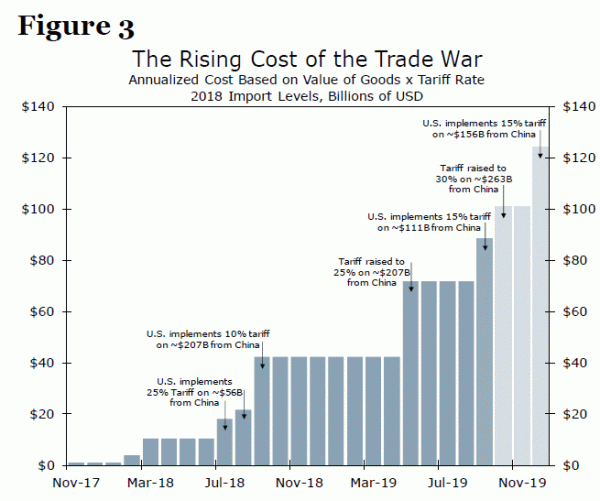
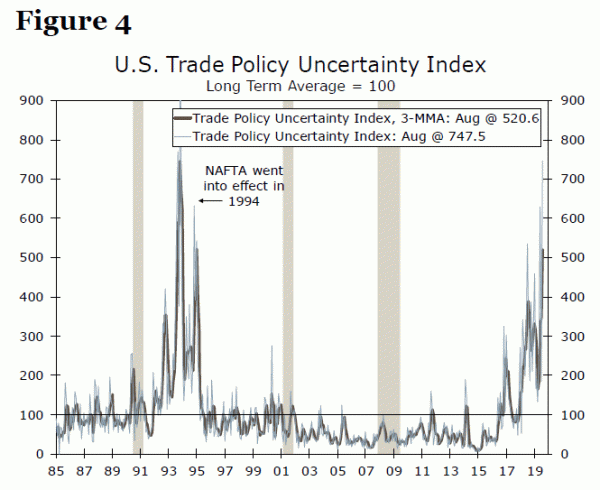
In this scenario, not only will the FOMC cut rates, but it will maintain its pledge “to act as appropriate to sustain the expansion.” In addition, a sizeable number of dots will shift down to 1.63% at the end of 2019. In the last Summary of Economic Projections (SEP), released at the conclusion of the June 19 FOMC meeting, 7 of the 17 FOMC members saw the fed funds rate ending the year at 1.88%. There were no dots below 1.88%. If, as we expect, the FOMC delivers another 25 bps rate cut on September 18, then the mid-point of the target range for the fed funds rate will indeed stand at 1.88%. Although it may be a stretch to expect that 9 FOMC members (i.e., the median voter) will shift their dot down another 25 bps, we think that a sizeable number, maybe 6 or 7, will shift down to 1.63% by the end of 2019. Such a shift would suggest that another 25 bps rate cut by the end of the year is a real possibility.
Scenario 2: The Wasted Bullet
- Fed funds rate: 25 bps cut
- Language: Neutral to Hawkish–Pledge to monitor risks to the outlook
- Dots: Most dots remain at 1.88% at the end of 2019
- Probability: 25%
While Chair Powell and many of his colleagues have done little to push back on market expectations of a September rate cut, hints about what is likely to come after September have remained notably absent in recent public comments. The unpredictability of current trade policy makes it particularly hard to look into the future, leading to the possibility of the FOMC limiting its forward guidance at this time in an effort to keep its options open.
In this relatively more hawkish scenario, the FOMC would cut the fed funds rate another 25 bps, but would be hesitant to signal subsequent moves. After all, overall economic activity remains in good shape. Slowing in the manufacturing sector has been offset by continued strength in consumer spending and in the service sector, while unemployment remains low. Trade talks appear to be back on, even if the situation did intensify in August. Furthermore, after cutting rates 50 bps since July, the committee would be willing to take its time to see how conditions unfold in light of the recent accommodation. The committee would pledge to closely monitor risks to the outlook stemming from global developments and financial instability, highlighting a number of members’ concerns that there are potential costs to cutting rates now.
The clearest signal that the FOMC is hesitant to add further accommodation in the near term, however, would come from the dot plot (Figure 5). In this scenario, one or two dots could shift lower to 1.63%, but the vast majority of dots would remain at 1.88%, indicating that most committee members currently believe that further easing is not needed between now and the end of the year. Furthermore, if Chair Powell indicates in his post-meeting press conference that the rate cut is part of a “mid-cycle adjustment,” as he did after the July 31 meeting, then market participants would also infer that the FOMC is not prepared to do much more this year.
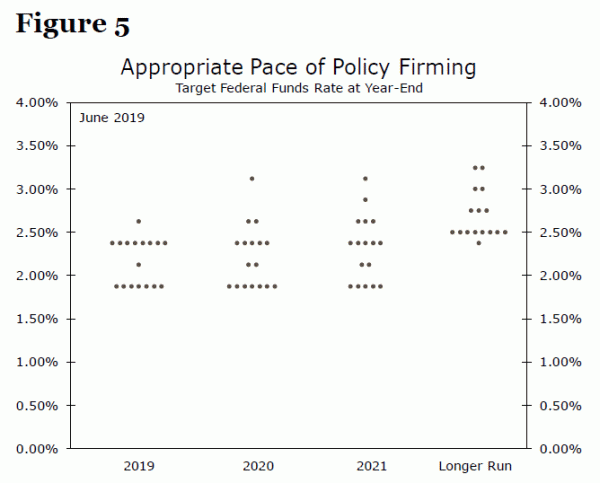
This more neutral stance on future policy would dull the impact of the meeting’s rate cut. Financial conditions, illustrated in Figure 6, would be even tighter now if not for market expectations of roughly 25 bps of additional easing this year beyond September. Quelling those expectations would likely lead to tighter financial conditions in the wake of next week’s meeting. We would expect the FOMC to be more mindful of such a risk after prior meetings where financial conditions tightened after it was perceived to have done too little. Not only would this tightening in financial market conditions fuel the need for additional easing in subsequent meetings, but the committee would have wasted one of its few bullets.
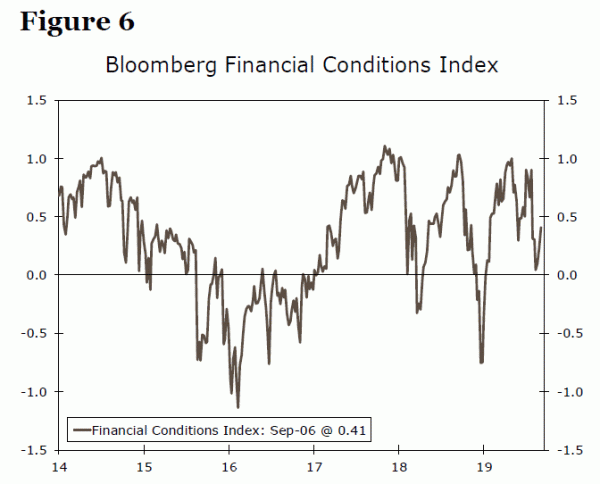
Scenario 3: No Time Like the Present
- Fed funds rate: 50 bps cut
- Language: Dovish–Will act as appropriate to maintain expansion, emphasis on obtaining 2% inflation target
- Dots: Most dots at 1.63%, but some dots fall to 1.38% at end of 2019
- Probability: 15%
It may not be Halloween yet, but yield curve inversions, flaring trade tensions and a more definitive slowdown in the manufacturing sector could very well be spooking some members of the FOMC at present (Figure 7). A 50 bps cut in September is therefore within the realm of possibility. The lag between policy implementation and its effects on the economy suggest there is no time like the present to add accommodation if officials feel it could be warranted in the coming months. With limited traditional ammunition in its arsenal, research suggests more potency to easing sooner rather than later.1
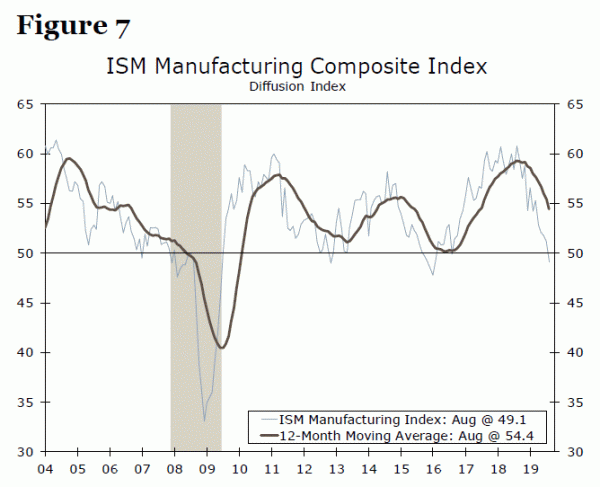
Currently yields all the way out to 30 years on the Treasury curve are below the fed funds rate (Figure 8), a new development since the July meeting. Although Fed officials have highlighted a number of potentially benign reasons for a flatter yield curve this cycle, such as quantitative easing, a number of committee members acknowledge it is still signaling significant risks to the outlook. A larger-than-expected cut in September would help steepen the yield curve, and reduce the chance that such a widely watched indicator contributes to investors “talking” the economy into recession. Financial conditions would ease more generally as well, supporting credit growth and the economy.
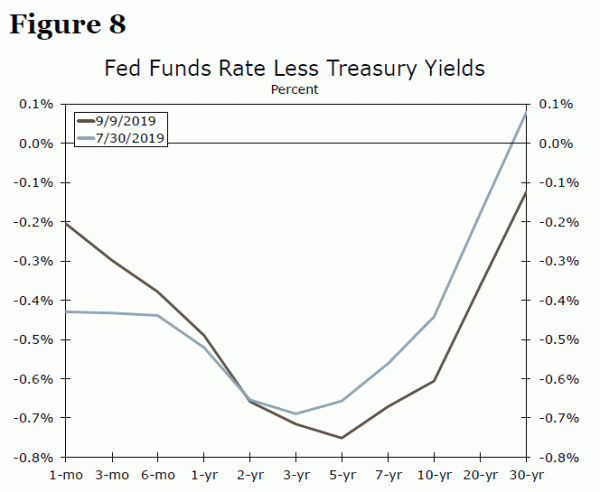
Time is also ticking on the Fed reaching its 2% inflation target on a sustained basis. With recession risks rising in recent months and core inflation still struggling to meet 2%, a 50 bps cut would signal the FOMC is serious about meeting its inflation target before the next downturn strikes and inflation expectations potentially fall further. With such urgency to move, a 50 bps cut may possibly not be the last of easing this year. Although most dots would fall to 1.63%, which would be the new mid-point of the target range for the fed funds rate, some dots could fall to 1.38%, indicating that these FOMC members see the need for further easing later this year.
A 50 bps cut, however, is still an outside chance in our view. With a number of FOMC members publically indicating reluctance to ease at all, getting a super majority of voters on board with such a bold move could be a very tall order.2 A 50 bps cut also risks being interpreted as a sign that the economy is in a more precarious position than it is. Historically, the FOMC has only cut 50 bps when the economy was more clearly on the brink of recession or struggling to emerge from one. Moreover, with the labor market still the tightest it has been in decades and inflation firming more recently, a 50 bps cut could be construed as the FOMC caving to political pressure, fueling scrutiny over its role as a politically independent institution.
1 Board of Governors of the Federal Reserve System, FOMC Briefing. January 2002.
2 The FOMC is a consensus-oriented institution. Formal dissents by more than two voting members are rare at any given FOMC meeting.

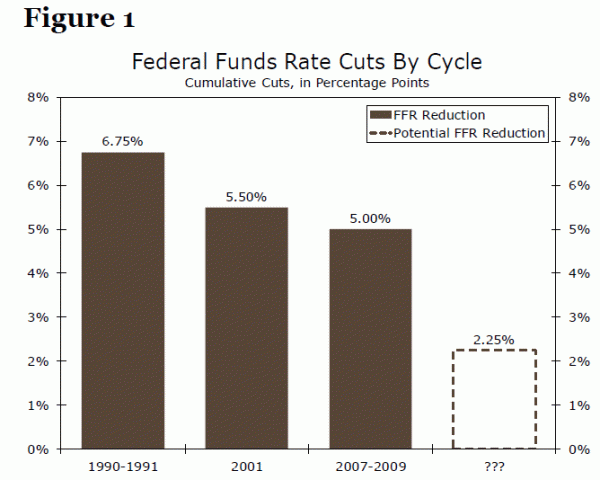
 Signal2forex.com - Best Forex robots and signals
Signal2forex.com - Best Forex robots and signals




